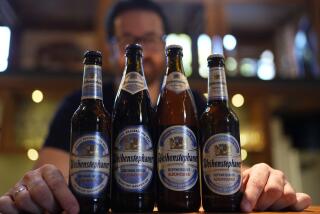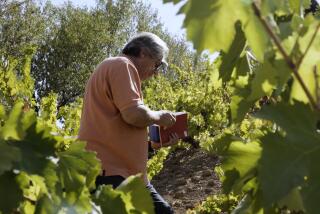Deciphering German Wine Labels : There Are Only Two Basic Quality Categories to Know
- Share via
Some of the world’s finest white wines are German but because their labels are hard to understand, Americans avoid them. And veteran shopkeepers, plagued by the same problem, often refuse to merchandise them.
It is a sad situation for German vintners who are bent on making the best wines and find little response in a marketplace apparently unwilling to grapple with the labels. Many long for the old days when some of Germany’s finest wines were brought here under the universally known name of Liebfraumilch , which means milk of the Blessed Mother. Several growers said that the only way they could sell their wines was under a popular, easy to grasp, single name. It was a simple, yet unsatisfactory, way of removing label concerns.
To understand German labels, it is essential to make note of a few easy rules. (Keep in mind that Germany produces principally white wine, with only 12% of its vineyards planted to red grapes.) Essentially, there are only two basic categories of quality, Tafelwein and Qualitaetswein . The former represents simple, everyday, inexpensive wine, while the latter has higher credentials, is costlier and produced in accordance with the style and tradition of regional tastes. What makes the system truly simple is that any German grower can make high-quality wine without the need for credentialed soils noted in France and Italy where quality generally follows a prejudged evaluation of vineyards.
Two Label Designations
In buying Tafelwein two label designations are used: Deutscher Tafelwein and Deutscher Landwein . The first is the simplest of all German labels and never carries a vineyard name. Generally, it is the kind of wine to which sugar may be added before fermentation to raise alcohol content, the process known as chaptalization. The second designation refers to wines likely to be of greater body, character and dryness and that may come from 15 so-called Landwein regions. Less than 10% of all German wines in the United States are likely to be labeled Tafelwein .
For Americans, greater interest will be centered around the two categories of Qualitaetswein : Qualitaetswein Bestimmter Anbaugebiet , referred to as QbA, and Qualitaetswein mit Pradikat . QbA is the so-called quality wine from a specific area and made of legally approved grape varieties with adequate ripeness and style to qualify for regional traditional taste. As the largest quantity of German wine, it is an easy category to remember because QbA’s are required to come from any one of 11 specific wine regions: Rheingau, Rheinhessen, Mosel-Saar-Ruwer, Nahe, Rheinfalz, Franken, Hessiche Bergstrasse, Mittelrhein, Ahr, Wurttenberg and Baden.
Actually, if you did nothing more than to digest those names and the initials QbA, you’d have little difficulty with German wine labels since most German wines found on store shelves are likely to be in this category. Reconciling the other Qualitaetswein , or QmP’s, is just as easy. Just remember that QmP is the same as QbA, except that it carries a special distinction or attribute to qualify as the finest of German wines. These are not permitted to be chaptalized and as a consequence are likely to be more delicate and less oppressively sweet, reflecting greater style and elegance.
Can German wines be that simple? Yes, but for complete understanding look for the words for special distinctions and attributes that relate to quality and harvest ripeness. For instance, the term Kabinett on a label designates a fine, light-styled wine of normally harvested grapes, perhaps the driest of all QmP’s.
Most familiar of German wine terms is Spaetlese , which indicates a fruitier, richer and fuller wine because of riper, superior quality grapes picked seven days after a normal harvest. Due to additional sun time, these wines are likely to be more intense and lush. A less familiar term is Auslese , which usually indicates a sweeter wine, made from specially selected, very ripe grapes with the added element that in certain vintages they will be affected by botrytis cinerea, the Noble Rot, or as the Germans call it Edelfaule . In prime harvests these can be superb, complex wines at reasonable, affordable prices.
Sweet Wines, Superb Elegance
Still another label term is Beerenauslese , affectionately referred to as BA, an attribute that is produced from individually selected, overripe or botrytised grapes. Here the wine is likely to be extremely sweet, in a rich, dessert style and with superb elegance. The richness of the wine also means it’s likely to be expensive.
Richest of all, however, in style and cost, is a wine with the term Trockenbeerenauslese , known as TBA, on the label. These wines have honey-like, rich, sweet flavors from dried botrytised grapes that are literally picked one by one. In great vintages it is sometimes difficult to differentiate between a BA and a TBA; nevertheless, both will be rich, with prices to match. Expect to find these in small quantity from just two or three vintages a decade. Always consider them great candidates for long term aging. In recent years, an ongoing debate has arisen concerning which is better for longer aging: TBAs or French Grand Cru Classe Chateau Sauternes with no clear-cut, final judgment. In fine vintages, both are capable of decades of aging.
Popular in recent years is the use of another German label designation, Eiswein . This indicates a sweet, concentrated wine produced from overripe grapes that are allowed to sit on the vine sometimes as late as January or February. The grapes are picked while frozen and pressed before they can thaw. Eiswein translates easily into ice wine and is a great rarity. Because the grapes must be in the BA category, expect the wines to be expensive.
Drier German wines will be designated Trocken , or Halbtrocken , defined as dry or semi-dry, respectively. Keep in mind that the former, though designated as dry, generally has around 9 grams of residual sugar per liter, making it slightly sweet, while the latter is sweeter still with 18 grams. Also note that both designations can appear on a bottle labeled as Auslese .
With German wines, it is not as critical to remember the names of grapes as with American varietal labels. There are a host of grape varieties used, but the principal names are Riesling, Muller-Thurgau, Silvaner and Gewurztraminer. Riesling is the best known with 20% of the country’s plantings, while Muller-Thurgau is the most widely planted at 26%. A grape name can appear on a German label only if 85% of one grape is used in making the wine.
While the crop was not large, 45% below the average for the preceding five years, there are many bargains to be found in the outstanding vintage of 1985. Look for QbA of Kabinett, Spaetlese and Auslese quality, especially from the Mosel. From other major regions there is a larger supply of QmPs. Except for the big-name BAs, TBAs and Eisweins , almost all German wines can be enjoyed upon purchase. Though many can stand some aging, depending upon sweetness, long term cellaring is not the basic goal. Be careful not to overchill these wines so you don’t miss the subtle scents of spring flowers and elegant flavors.
More to Read
Eat your way across L.A.
Get our weekly Tasting Notes newsletter for reviews, news and more.
You may occasionally receive promotional content from the Los Angeles Times.










